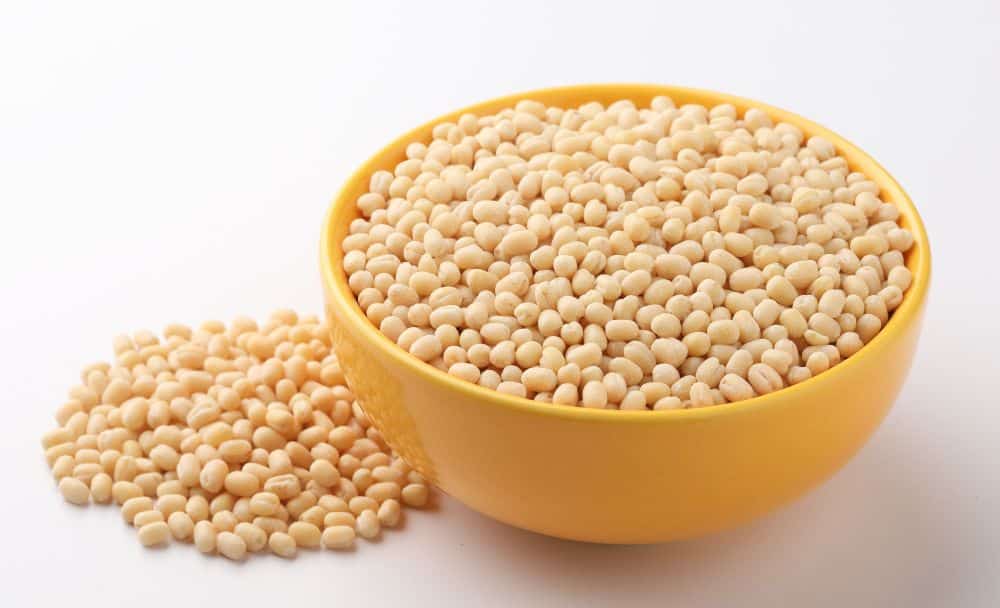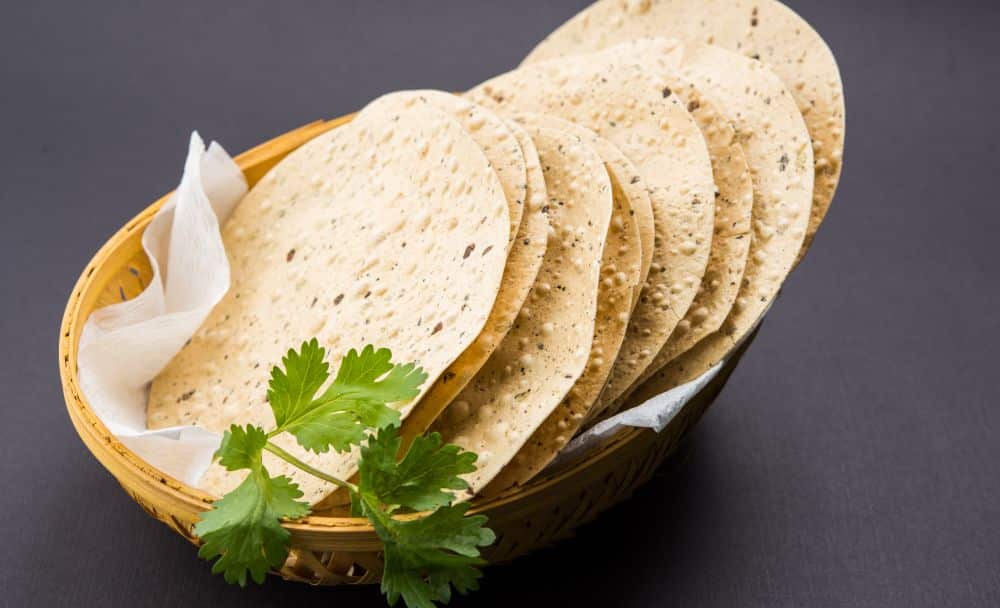Urad dal, also known as black gram or Phaseolus mungo belongs to the family Fabaceae and genus Phaseolus. It is a highly nutritious pulse that has been a dietary staple in India for centuries. With its rich flavor, versatility, and numerous health benefits, urad dal has become a popular ingredient not only in Indian cuisine but also in many other parts of the world, such as Australia, Thailand, and the South Pacific. From its protein-packed content with good amounts of urad dal protein like albumin and globulin and amino acids like tryptophan and lysine, black gram offers a range of advantages for overall well-being. [1] In this article, we will delve into the urad dal benefits, uses, potential side effects, and more, shedding light on why urad dal deserves a prominent place in a balanced and nutritious diet.
Urad Dal Nutrients
Urad dal is rich in essential nutrients, and that makes it a valuable addition to a balanced diet. Given below is the nutritional profile of 1 cup (100 grams) of urad dal:
- Total ash content: 4.5 – 5.5 percent
- Crude Fat: 1.54 percent
- Crude Urad dal Protein: 25-28 percent
- Crude Fiber: 4.90 percent
- Carbohydrate: 62 – 65 percent
- Physiological energy: 350 cal
- Insoluble dietary fiber: 14.09 percent
- Soluble dietary fiber: 4.19 percent
- Total dietary fiber: 20 percent
- Calcium: 94.43 mg
- Iron: 6.97 mg
- Trypsin inhibitor: 93.21 TIU/ g
- Tannin: 6.945 mg/g [1]
What are the benefits of Urad Dal?
1. High in Fiber
Urad dal is loaded with dietary fiber, and this property of the food helps to modulate lipid homeostasis in people with a high-saturated-fat diet, aid in digestion, and prevent constipation.
2. Blood Sugar Regulation
The low glycemic index of urad dal makes it suitable for individuals with diabetes. It helps regulate blood sugar levels and prevents sudden spikes in glucose.
3. Controls body weight
Yet another of the several urad dal benefits include its ability to help manage weight by inducing a feeling of fullness and thus limiting overall food consumption. [2]
4. Rich in Protein
Urad dal benefits also include its property of being an excellent source of plant-based protein, making it an essential food for vegetarians and vegans. it is highly rich in protein
5. Has antioxidant and anti-inflammatory properties:
It helps enhance the immune defense and lower the risk of cancer, infection, and other degenerative diseases. [3]
6. Heart Health
Fiber and other urad dal nutrition contribute to heart health and prevent cardiovascular and coronary heart disease risk. [4]
7. Bone Health
It is believed that the root nodule of black gram is narcotic and diuretic and is thus used as a remedy for rheumatism, aching bones, dropsy, and cephalgia. Regular consumption of urad dal may help prevent conditions like osteoporosis. [6]
Traditional uses of Urad Dal
1. Culinary Applications
Urad dal is a versatile ingredient in various traditional Indian dishes. It is commonly used in a fermented form to make idli (fermented rice and lentil cakes), dosa (thin pancakes), vada (savory fritters), and papad (thin, crispy lentil wafers). [4]
2. Flour
Urad dal can be ground into fine flour and used to make various dishes, such as dosa batter, idli batter, gluten-free bread, cakes, biscuits, snacks, cookies, and doughnuts. [5]
3.Sprouts
Sprouts produced from black gram are also consumed as a vegetable primarily because they contain high amounts of vitamins and minerals. [5]
4. Other uses
Urad dal nutrition is used for hair problems, increasing energy, treatment of dandruff, treating nervous disorders, treating digestive disorders, and helping pregnant women, among others. [6]
Side Effects and Precautions to be adopted while using urad dal
While urad dal offers numerous health benefits, there are a few considerations to keep in mind. It is known to disrupt the oxidant/antioxidant balance. It is known to disrupt the oxidant/antioxidant balance. Such an imbalance in the antioxidant enzymes can then lead to the release of free radicals and pose a risk of increasing lipid peroxidation. [3]
- It should be avoided by those who are prone to rheumatic disease and urinary calculi.
- Urad dal is considered unsafe for rheumatic patients because of its high concentration of Oxalic acid.
- Pregnant women suffering from the issue of constipation should avoid black gram.
- Patients with gallstones, kidney stones, and gout should avoid its consumption as it could aggravate their conditions by elevating uric acid levels. [6]
FAQs about Urad Dal
1. How does urad dal serve as an Ayurvedic medicine?
In Ayurveda, urad dal is called Masha or a bean that is sweet to taste but hot in potency that can calm down and regularize the imbalances caused due to Vata. It is also known as the agent that increases Kapha and Pitta and is recommended for men who have erectile dysfunction, low sperm count, and motility. It has several medicinal properties and is also believed to strengthen the nervous system, improve digestion, and promote hair and skin health.
2. How often can urad dal be consumed?
One can consume about ¾ to 1 cup of black gram daily.
3. What is the most popular urad dal recipe?
Dosa is the most popular urad dal recipe in which the ingredient is used in a fermented and ground form which is then spread across a hot skillet to form a thin pancake. Yet another popular urad dal recipe is black gram fritters which include other ingredients like kale leaves, ginger, and green chili, all ground into a smooth paste with the black gram fried in hot oil in the form of fritters.
Conclusion
Urad dal is a nutrient-dense legume that offers a wide range of health benefits. It is high in vital minerals, proteins, and fiber, making it a valuable addition to a balanced diet. Urad dal is a versatile ingredient used in various Indian dishes, and its flour can be used to prepare gluten-free recipes. While urad dal nutrition is generally safe for consumption, it is important to be mindful of potential side effects and precautions, especially for individuals with specific health conditions. In this article, we have discussed how Incorporating urad dal into the diet can be a healthy choice.
Disclaimer: This article is written from a health and wellness perspective and is not medical advice. Kindly seek the help of a certified medical practitioner before initiating any treatment.
References:
- Nutritional quality evaluation of improved varieties of black gram (Phaseolus mungo)
- Black Gram
- Comparative effect of horse gram and black gram on inflammatory mediators and antioxidant status
- Rheological, physico-sensory, nutritional and storage characteristics of bread enriched with roller milled fractions of black gram (Phaseolus mungo L.)
- Genetic diversity of the black gram [Vigna mungo (L.) Hepper] gene pool as revealed by SSR markers
- Isolation and Characterization of Binding agent from Black Gram





















